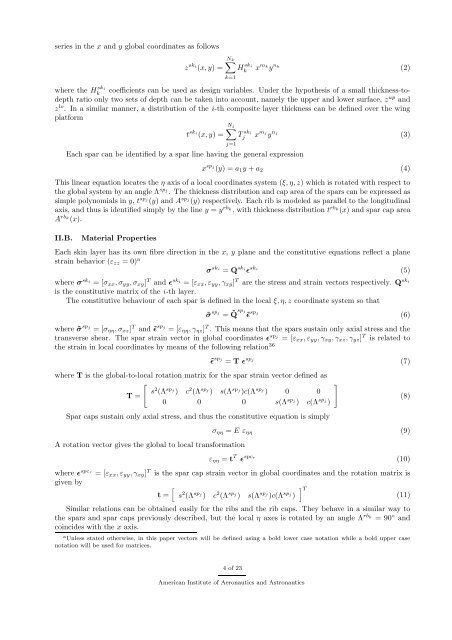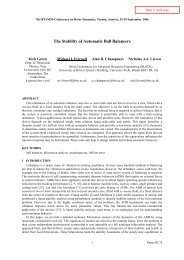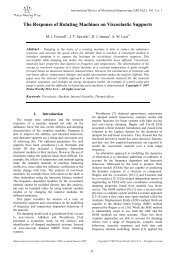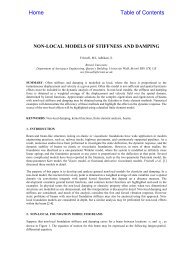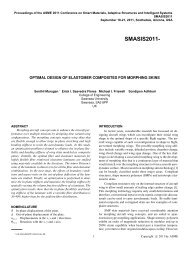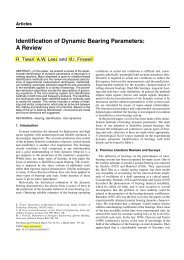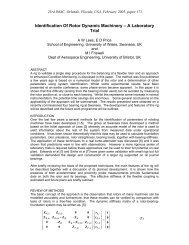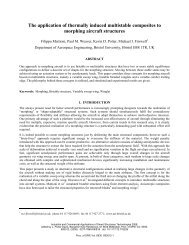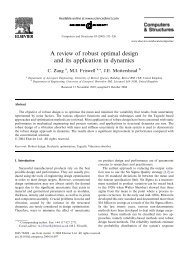Modelling Continuously Morphing Aircraft for ... - Michael I Friswell
Modelling Continuously Morphing Aircraft for ... - Michael I Friswell
Modelling Continuously Morphing Aircraft for ... - Michael I Friswell
You also want an ePaper? Increase the reach of your titles
YUMPU automatically turns print PDFs into web optimized ePapers that Google loves.
series in the x and y global coordinates as follows<br />
∑N k<br />
z ski (x, y) = H ski<br />
k<br />
x m k<br />
y n k<br />
(2)<br />
k=1<br />
where the H ski<br />
k<br />
coefficients can be used as design variables. Under the hypothesis of a small thickness-todepth<br />
ratio only two sets of depth can be taken into account, namely the upper and lower surface, z up and<br />
z lo . In a similar manner, a distribution of the i-th composite layer thickness can be defined over the wing<br />
plat<strong>for</strong>m<br />
N<br />
∑ j<br />
t ski (x, y) = T ski<br />
j<br />
x mj y nj (3)<br />
Each spar can be identified by a spar line having the general expression<br />
j=1<br />
x spj (y) = a 1 y + a 2 (4)<br />
This linear equation locates the η axis of a local coordinates system (ξ, η, z) which is rotated with respect to<br />
the global system by an angle Λ spj . The thickness distribution and cap area of the spars can be expressed as<br />
simple polynomials in y, t spj (y) and A spj (y) respectively. Each rib is modeled as parallel to the longitudinal<br />
axis, and thus is identified simply by the line y = y rb k<br />
, with thickness distribution t rb k<br />
(x) and spar cap area<br />
A rb k<br />
(x).<br />
II.B. Material Properties<br />
Each skin layer has its own fibre direction in the x, y plane and the constitutive equations reflect a plane<br />
strain behavior (ε zz = 0) a σ ski = Q ski ǫ ski (5)<br />
where σ ski = [σ xx , σ yy , σ xy ] T and ǫ ski = [ε xx , ε yy , γ xy ] T are the stress and strain vectors respectively. Q ski<br />
is the constitutive matrix of the i-th layer.<br />
The constitutive behaviour of each spar is defined in the local ξ, η, z coordinate system so that<br />
˜σ spj = ˜Q spj˜ǫ spj (6)<br />
where ˜σ spj = [σ ηη , σ xz ] T and ˜ǫ spj = [ε ηη , γ ηz ] T . This means that the spars sustain only axial stress and the<br />
transverse shear. The spar strain vector in global coordinates ǫ spj = [ε xx , ε yy , γ xy , γ xz , γ yz ] T is related to<br />
the strain in local coordinates by means of the following relation 36<br />
˜ǫ spj = T ǫ spj (7)<br />
where T is the global-to-local rotation matrix <strong>for</strong> the spar strain vector defined as<br />
[<br />
]<br />
s<br />
T =<br />
2 (Λ spj ) c 2 (Λ spj ) s(Λ spj )c(Λ spj ) 0 0<br />
0 0 0 s(Λ spj ) c(Λ spj )<br />
Spar caps sustain only axial stress, and thus the constitutive equation is simply<br />
A rotation vector gives the global to local trans<strong>for</strong>mation<br />
σ ηη = E ε ηη (9)<br />
ε ηη = t T ǫ spcr (10)<br />
where ǫ spcr = [ε xx , ε yy , γ xy ] T is the spar cap strain vector in global coordinates and the rotation matrix is<br />
given by<br />
[<br />
] T<br />
t = s 2 (Λ spj ) c 2 (Λ spj ) s(Λ spj )c(Λ spj )<br />
(11)<br />
Similar relations can be obtained easily <strong>for</strong> the ribs and the rib caps. They behave in a similar way to<br />
the spars and spar caps previously described, but the local η axes is rotated by an angle Λ rb k<br />
= 90 ◦ and<br />
coincides with the x axis.<br />
a Unless stated otherwise, in this paper vectors will be defined using a bold lower case notation while a bold upper case<br />
notation will be used <strong>for</strong> matrices.<br />
(8)<br />
4 of 23<br />
American Institute of Aeronautics and Astronautics


